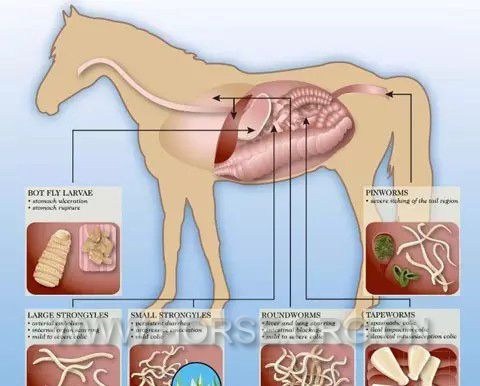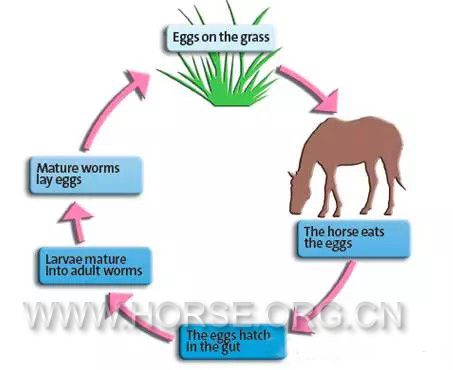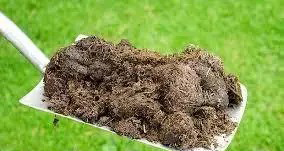马上注册,结交更多马友,享用更多功能
您需要 登录 才可以下载或查看,没有账号?立即注册
x
如何进行马场的寄生虫的防控?
Worming horses is a complex topic and no simple single system fits all horses in all conditions. There is no magic formula to use a particular drug a number of times per year and everything will be OK at your stable. However, once you understand the biology and life cycle of the intestinal parasites, you with the help of a veterinary consultant, can plan an effective control programme.
马匹的驱虫是一个复杂的话题,一个简单的驱虫系统不能被用在处于不同情况下的不同马匹。“每年给马用几次,就能保马匹平安的药”的神奇配方是不存在的。然而,一旦你理解了肠道寄生虫的生理和生命周期,在你和兽医顾问的共同协作下,你们能制定一个有效的控制体系。

Horses are commonly afflicted by parasites, primarily by a group of worms known as the “Strongyles.” Most adult horses acquire little immunity to most of these parasites and are quite susceptible to infection and disease. Although the most common result of parasitism is ill thrift, parasites also are a major cause of colic. A well-designed parasite control program on horse farms consistently reduces the incidence of colics by nearly 90%. However, in recent years the most common worms of horses have become resistant (the worms do not die) to many of our worm medicines. It now appears that our worming procedures will have to change if we are to continue to have good parasite control in our horses.
马时常受到寄生虫的折磨,其中最主要的是一类被称为“圆线虫属寄生虫”(Strongyles)。大部分成年马对这类寄生虫几乎没有免疫力,且很容易被感染,生病。寄生虫所导致的,最常见的后果是马“不健壮”,同时,寄生虫也是导致腹痛的主要原因之一。一个适用于马场的,设计良好的寄生虫防控体系能持续不断的降低腹痛的发生率,将其降低至近90%。然而,在近十年,马匹中最常见的寄生虫对我们现有的药物都产生了抗药性。现在看来,如果我们希望能持续不断的控制寄生虫,那么我们的寄生虫防控体系需要改变。
The most important equine parasites are the large strongyles (particularly Strongylus vulgaris), small strongyles (bloodworms or cyathostomes), and ascarids (large roundworms). The strongyles are seasonally transmitted, so treatment programs will be coordinated with time of the year, whereas ascarids are transmitted year-round, with season having very little effect. Less important, but not to be ignored, are bots, pinworms, threadworms, and tapeworms.
马房管理中,尤其需要重视的是:大型圆虫(large strongyles)尤其是普通圆线虫( Strongylus vulgaris);小型圆线虫(small strongyles)(蚯蚓或盅口线虫);蛔虫属(ascarids )(如大蛔虫large roundworms)。圆虫的传播是季节性的,因此相应的治疗方案需要根据季节调整;而蛔虫则是一年四季都会传播,季节的变化对其的传播几乎没有影响;蝇蛆病、蛲虫、线虫、绦虫相对不那么严重,但是也不应该被忽视。
Mature horses are susceptible to all of the above except ascarids and threadworms, whereas foals are not likely to harbor adult large strongyles until they are at least 6 months old. The large and small strongyles are acquired primarily, but not only, by grazing and are dependent upon horses having access to grass. Worm larvae can also contaminate hay fed from the ground and infect stabled horses quite readily. Tapeworms are similarly dependent upon the presence of grass to support the tiny mite that spreads them. These parasites are not easily transmitted in very well-cleaned and bedded stables, where hay is fed from hay feeders attached to the wall.
成年马对上述除线虫和蛔虫以外的寄生虫都敏感,反之出生6个月以内的马驹体内大多不会存有大型圆虫。大型和小型圆虫的感染条件包括但不仅限于放牧吃草,喂草。圈养于马厩的马还有因为吃地上的饲料而感染寄生虫的幼虫。于此相似的还有绦虫,也是凭借寄生在牧草中的螨虫作为传播载体。这些寄生虫在干净的,马房垫料被及时清理,通过安装在墙上的料桶给马喂草料的马厩中并不容易被传播。
In contrast ascarids and pinworms can be acquired from grassy or non-grassy environments. Indeed, pinworm transmission is especially rapid in stabled horses where the delicate eggs are concentrated and protected from direct sunlight.
相比之下,无论有没有草场(放牧场)的环境,马都容易感染蛔虫和蛲虫。在光照不足,虫卵集中的马厩,蛲虫的传播尤为迅速。
盅口线虫(小型圆虫)
Cyathostomes (“Small Strongyles”) These are by far the most common and abundant of the major parasites of horses, with infections often exceeding 100,000 worms in a horse. Damage to the horse’s gut by developing larvae of these worms can lead to ill thrift, diarrhea and colic.
盅口线虫(小型圆虫) 这是目前最常见的寄生虫之一,在受到感染的马体内通常有超过100,000个蠕虫。这些寄生虫的幼虫的成长可损害马的肠道,导致马不健壮,腹泻和腹痛。
Adult cyathostomes live in the gut of horses, and infected horses shed cyathostome eggs in their manure. The eggs then hatch into larvae that feed on bacteria in the manure for a week or two before migrating out of the manure onto nearby blades of grass. Horses then acquire the larvae from the pasture as they graze. If the horses live in pens or stables that do not have any grass but may be contaminated with manure, then the horse will become infected by eating hay fed from the ground. Once swallowed, larvae develop in the wall of the horse’s gut for about 4-6 weeks before maturing to egg laying adult worms, although some can remain dormant in the gut wall for a year or more without maturing.
成年盅口线虫寄生在马的肠道中,受到感染的马会通过粪便传播虫卵。虫卵 孵化成幼虫后,以粪便中的细菌为生,并于一到两周后迁移到周围的牧场上。马又通过在草场吃草,吃入幼虫。即使是圈养在没有草场环境的马厩中的马,如果马厩中有粪便。那么马仍然有可能因为在地面吃饲料,而受到感染。幼虫一旦被吃入腹中就会吸附在肠壁,4-6周后成年并能产卵;其中有一些会在肠道中处于休眠状态长达一年以上。

In cool climates, cyathostome transmission is fairly straightforward. In Spring it is common for a “spring rise” in worm egg output in the manure of horses. This results in a dramatic rise in the number of worm larvae on pastures by late summer and autumn. Horses become heavily infected by grazing during this time. In hot dry climates the situation is reversed. Although worm egg counts remain high in horse manure year round, the infective larvae of these worms survive poorly on grass during the hot dry summer months. The net result is that most parasite transmission takes place from November to April, when horses ingest larvae that developed from eggs shed onto pasture from September to March.
在天气凉爽的地方,盅口线虫的传播相当简单。在春季通常容易出现“春潮”,马粪中寄生虫虫卵暴增。这又导致夏末,和秋季时草场中幼虫数量的暴增。马在此期间严重感染寄生虫。在气候炎热干燥的地方,情况则相反。尽管一年中马粪中虫卵数量高,在炎热干燥的夏季,这些幼虫的在草场的成活率很低。这导致马感染寄生虫的时间转而变成11月到次年4月,而马感染幼虫,通过粪便排出,传播虫卵的时间转变到9月到次年3月。

盅口线虫最主要的两个特征
Two important features of cyathostomes:
(1) Their short life cycles as compared to the large strongyles
(2) Their ability to develop resistance to commonly used wormers, which must be taken into consideration when designing parasite control programs.
盅口线虫最主要的两个特征:
(1)与大型圆虫相比,它们的生命周期短,
(2)它们对常见驱虫药产生抗药性的能力,这是我们在制定寄生虫防控计划时必须要考虑的一点。
In, hot dry climates, treatment at 2 month intervals with ivermectin, 3 month intervals with moxidectin, or monthly intervals with most other wormers from September through March will control most cyathostomes, as will continuous daily treatment with Strongid-C during this time. In cold climates, these treatments should be given late spring through summer.
在炎热干燥的气候,每2个月使用一次伊维菌素,每3个月使用一次莫西菌素,或者从9月到3月,每个月用其他的驱虫药,这将能控制大部分盅口线虫,同时在这期间每天使用Strongid? C。在气候寒冷的地方,这些治疗方案应该从春末开始实施,贯穿整个夏季。
Unfortunately, many horses are infected with cyathostomes resistant to the benzimidazoles (BZDs), the largest class of wormers. Since there is cross-resistance throughout the BZD group, this means that wherever resistance occurs, products containing febendazole, oxfendazole , and febantel are not effective. One drug of this group worms are much slower to develop resistance to is oxibendazole, thus it may be effective when worms are resistant to the other BZDs. BZD-resistant worms are fully susceptible to ivermectin, pyrantel, or moxidectin, and these wormers should be used wherever BZD resistance has been identified.
不幸的是,很多马感染的盅口线虫对苯并咪唑有抗药性,这是驱虫药中的最大类别。在苯并咪唑类中存在交叉抗药性,这意味着抗药性可能随时出现,含有氟苯哒唑,奥芬达唑,苯硫胍的驱虫药没有效。这类药中,寄生虫对氧苯达唑产生抗药性的速度较慢,因此在寄生虫对苯并咪唑类有抗药性的情况下,它或许会有效果。对苯并咪唑类有抗药性的寄生虫对伊维菌素,噻嘧啶吡喃呔,莫西菌素非常敏感,当确定寄生虫对苯并咪唑类驱虫药有抗药性时候,就应该用上诉驱虫药。
Faecal worm egg counts are a good guide to determine if your horse requires worming. These are a standard procedure veterinarians perform which helps us assess an equestrian centres success at keeping worms under control. Initially it is essential to run faecal egg counts on all horses in the stable to find which individuals are struggling to remain parasite free and which ones have a better immune system and can keep worms at bay.
粪便中虫卵的数量是一个确定你的马是否需要驱虫的好方法。兽医们有一个“标准流程”可遵循,这样的流程帮助我们通过“确保寄生虫得到控制”来协助马术中心成功。首先,最重要的是对马场所有的马匹进行“虫卵粪检”,来找出那些受寄生虫困扰的马,以确保控制寄生虫;同时还需要找出那些免疫系统功能较强能抑制寄生虫的马。
年度寄生虫防控计划
An annual worming program needs to address all these types of worms correctly. A professional veterinary designed worming program combines appropriate anthelmintic drug use, environmental hygiene control and faecal egg counts. This 3-phase programme is the most cost effective and reduces the chance of drug-resistance to any of the anthelmintics occurring. Drug resistance is a very serious problem for all horse owners to be aware of and use the anthelmintic drugs with care and precision. There is no point in giving a worming drug to a horse if the drug does not work. Again, a waste of time and money.
年度寄生虫防控计划需要妥善的将下列寄生虫纳入考虑范围。一个专业兽医设计的驱虫计划应该结合适当的药物的选择,环境卫生控制,和虫卵粪检。这三项是最经济,恰当的药物选择能降低寄生虫抗药性风险。寄生虫产生抗药性对所有的马主来说都是一个非常严重的问题,对马主来说,应该意识到了解,应用适当的精确的药物,使用时应更慎重。
There is nothing better for your horse’s general health than an individually tailored feeding and de-worming programme. This is the basis of good horse husbandry and doing one well and ignoring the other is a waste of time.
对你的马来说,为每匹马量身定制饲养计划和驱虫计划是对整个马群健康来说非常好的事情。这是好的马房管理的基础,同时,如果只重视个别而忽视马群中的另一些,是在浪费时间。
来源:Dr.K的小课堂
|
|
